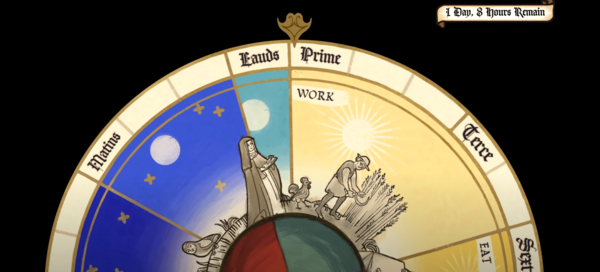What Is Obsidian’s Pentiment?
We spoke to Josh Sawyer about his decades-old ideas for Pentiment, and how he finally brought this medieval mystery to fruition.
Josh Sawyer’s just-announced medieval narrative mystery, Pentiment, has been in development for about four years now. But if you ask Sawyer, it really started way, way back in 1992.
At the time, Sawyer was enjoying an RPG called Darklands, developed by Microprose Labs for MS-DOS. It was set in the Holy Roman Empire in the 15th century, but with a supernatural bent that left room for demons and Templar conspiracies. Sawyer fell in love with its approach to historical fiction, and as he went on to get a degree in history and subsequently work in games, the idea of a historical fiction game stuck with him.
Sawyer first pitched the seed of what would become Pentiment to now-Obsidian CEO Feargus Urquhart back when they were still working at Black Isle together. There, Sawyer was a designer working on projects like Icewind Dale 2 and the original, cancelled Fallout 3. As Sawyer explains it, Urquhart was “not into” his pitch at the time, and felt people who wouldn’t know history wouldn’t want to play it.
But Sawyer disagreed, and the idea came up once more years later when the two were reunited at Obsidian Entertainment, where Sawyer was the lead designer on Fallout: New Vegas and Pillars of Eternity, and the director on Pillars of Eternity 2: Deadfire. During the lull after Deadfire, while discussions about a Microsoft acquisition were floating around, Sawyer revived his old pitch as a narrative adventure game. It was not quite a murder mystery, but with mystery elements, with a strong visual style and gameplay, like Night in the Woods, Mutazione, or Oxenfree. It would incorporate exploring, talking to people, and little puzzles sprinkled throughout. Sawyer knew what he pitched would be niche, so he wanted a fairly small team and didn’t want to do anything too mechanically complex.
This time, his pitch won out, and Sawyer got to work on Pentiment: a 16th-century narrative adventure set in Upper Bavaria. As he explains it, you play as Andreas Maler, a journeyman on the cusp of becoming a master artist who’s traveling around Europe, taking on odd jobs as he goes. While staying at a Benedictine abbey and working on an illuminated manuscript, his friend and mentor is accused of the murder of a prominent individual. His friend claims innocence, but no one seems especially interested in investigating who the real murderer is. That leaves Andreas to step up to the job, becoming a medieval detective of sorts as he speaks to the many suspects.
“One of the key things in the game is that we do not ever definitively tell you, canonically, [who] the murderer [is],” Sawyer explains. “You have to investigate, find as much evidence as you can. You make your decisions based on whatever you think is most important. You are basically deciding who's going to pay for the crime. That can be the person that you think actually did it. That can be the person that you think should be punished, whether or not they did it. Maybe it's the person you like least. Maybe it's the person you think that the community will miss the least.”
But the scenario Sawyer describes is just the beginning of Pentiment. In total it covers a span of about 25 years, during which multiple crimes, murders and conspiracies occur that Andreas gets roped into somehow or another. But despite the detective story bent of Sawyer’s explanation, he’s averse to calling Pentiment a detective game, because he says it’s light on detective game mechanics. It’s a narrative adventure, he says, with mystery and murder elements, and where choices have consequences. For instance, Andreas is an artist with a university education, but players can choose what he excelled at in school. That choice will dictate the kinds of conversations he’s able to have with others as he tries to find information about various crimes.
Aside from its narrative, one of Pentiment’s core elements is one that immediately stands out in its trailer: the art. Sawyer says without art director Hannah Kennedy’s ideas and execution for the style, Pentiment may never have even existed. In fact, for a time early on in the project, Pentiment was mostly just the two of them. “I really believe that if I had gone to Hannah and said, ‘Hannah, I have this idea for this style,’ and she either wasn't interested, or just [couldn’t make it work], I would’ve dropped it. I wouldn’t have done it,” Sawyer says.
His pitch to Kennedy was a pretty specific and strange one: Sawyer wanted to mix late medieval manuscripts with woodcuts and engravings and early print, to better show off the transitory period between late medieval and early modern art. And Kennedy delivered.
“One of the things that I think is really great about her is that she is very good at critically analyzing how a piece of art is put together in terms of line weight and color, where colors go and where they don't, where blacks go and where they don't, when ink is used rather than paint, and things like that,” Sawyer says. “So she was able to deconstruct a lot of these images that we were looking at for reference, and then reconstruct a style guide so that she and the other artists on our team were able to synthesize this new style, which I just think is really compelling.”
For some, medieval manuscripts might be a bit daunting to look at, with their stylistic font choices. Sawyer reassures that accessibility was taken into account with an easy font mode, which he says was made possible in part due to Xbox’s support and interest in the project and access to its accessibility teams. In fact, the Xbox acquisition of Obsidian in 2018 brought a number of benefits to Pentiment specifically, and Sawyer says he had always conceived of it as an ideal GamePass game.
“I think that Microsoft and Xbox have access to a lot of accessibility,” he says. “Their accessibility labs are extremely helpful. “This game is not really supposed to be hard. … So having the accessibility labs to give the game to people who have different limitations than you or I might, it's really great to get feedback like, ‘This text is hard to read. We need better contrast. We need more options. We need text to speech.’ All sorts of things like that are extremely helpful to us. We normally wouldn't have access to those resources.
“Also, honestly, Microsoft's access to localization is really important. This game is very text heavy, [it’s] an Obsidian game. Especially when people play it not in English, the quality of the localization is going to make or break their experience.”
Sawyer says that while the setting and style are quite different, Pentiment explores a number of the same themes as his past work on New Vegas and both Pillars of Eternity games, in particular death, social transformation, and class conflict. Specifically, Sawyer says Pentiment examines these ideas by showing a broad, diverse portrait of medieval society and the numerous types of people who made it up.
“I wanted to show a wide spectrum of people in this community, which is why it's not just monks, but it's monks, the nuns that live in the house near them,” he says. “It's the peasantry, the crafts people, the smith, the miller who everyone hates because he's awful, as is often the case. I wanted to show the breadth of society and portray it as well as I could.”
While Sawyer is aware that Pentiment is a bit niche, with its deep exploration of medieval history, art, and culture, he feels that watching the trailer shown today at the Xbox Game Showcase is a pretty good benchmark to gauge whether or not an individual will like it. But he also says he wants to capture an audience interested in history or medieval art who may not necessarily be dedicated gamers or familiar with his past work. And his ultimate goal for Pentiment is for it to be, at least on some level, educational for anyone who picks it up.
“If people don't know anything about history, and they just like the look of it and the idea of it, I want them to play it and passively absorb knowledge as they go through it,” he says. “I want them to enjoy the story, be entertained by it, but also gain a greater understanding of how people lived in the 16th century.”



on our hands.









![Glory to Codexia! [2012] Codex 2012](/forums/smiles/campaign_tags/campaign_slushfund2012.png)























